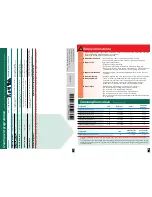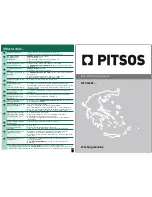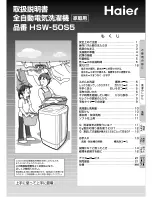
7
O
v
e
rv
ie
w
o
f
p
ro
g
ra
m
m
e
s
a
r
e
fe
r
to
t
h
e
t
a
b
le
o
f
co
n
s
u
m
p
ti
o
n
v
a
lu
e
s
o
n
p
a
g
e
8
a
n
d
n
o
te
s
o
n
p
a
g
e
6
.
P
ro
g
ra
m
m
es
°C
m
ax
.
Ty
pe
of la
undr
y
A
dditiona
l func
tions
; inf
or
ma
tion
ƗƖơƗƖƟƚƥƑ
(C
ottons
)
ƣƩƵƨ
(c
ol
d
),
2
0
, 4
0
6
0
, 9
0
°
C
7
k
g
H
ar
d
-w
ea
ri
ng
fa
b
ri
cs
, h
ea
t-r
es
is
ta
nt
fa
b
ri
cs
m
ad
e
of
co
tto
n
or
li
ne
n
c
ƞƢƤƖƨƦ
ƧƖƛ
y
ƚƤƥƚ
,
c
ƚƩƚƥ
ov
Ɨ
Ʀƞ
Ʃƴ
Ƶ
(N
o
sp
in
)
ƗƖơƗƖƟƚƥƑ
+
ƥưƠƩƧƜ
(C
ottons
+ P
re
w
as
h)
6
0
°
C
ƧƩ
v
Ɲƚ
ƨƞƟ
Ƒ
(
E
as
y-
C
ar
e)
ƣƩƵƨ
(co
ld)
, 4
0
°
C
3
k
g
E
as
y-
ca
re
fa
b
ri
cs
m
ad
e
of
c
otto
n,
li
ne
n,
s
yn
th
eti
c
fib
re
s
or
b
le
nd
ed
fa
b
ri
cs
c
ƞƢƤƖƨƦ
ƧƖƛ
y
ƚƤƥƚ
,
c
ƚƩƚƥ
ov
Ɨ
Ʀƞ
Ʃƴ
Ƶ
(N
o
sp
in
)
eu
ƖƝƓ
(D
elic
at
es
)
ƣƩƵƨ
(co
ld)
2
k
g
Fo
r
d
el
ic
ate
, w
as
ha
b
le
fa
b
ri
cs
, e
.g
. m
ad
e
of
s
ilk
, s
ati
n,
sy
nth
eti
c
fib
re
s
or
b
le
nd
ed
fa
b
ri
cs
(e
.g
. c
ur
ta
in
s)
c
ƞƢƤƖƨƦ
ƧƖƛ
y
ƚƤƥƚ
,
c
ƚƩƚƥ
ov
Ɨ
Ʀƞ
Ʃƴ
Ƶ
(No
s
p
in
);
N
o
sp
in
b
etw
ee
n
ri
ns
e
cy
cl
es
ơƑƠƠƞƢƖ
(
W
o
o
l)
ƣƩƵƨ
(co
ld)
H
an
d
ä
o
r
m
ac
hi
ne
-w
as
ha
b
le
fa
b
ri
cs
m
ad
e
of
w
oo
l o
r
co
nta
in
in
g
w
oo
l
P
ar
tic
ul
ar
ly
g
en
tle
w
as
h
p
ro
g
ra
m
m
e
to
p
re
ve
nt
sh
ri
nk
ag
e
of
la
un
d
ry
. L
on
g
er
p
ro
g
ra
m
m
e
b
re
ak
s
(f
ab
ri
cs
r
es
t i
n
th
e
d
ete
rg
en
t s
ol
uti
on
)
A
d
d
iti
o
n
al
p
ro
g
ra
m
m
es
ƣƒƗƘƖƠơƖ
(R
ins
e),
ƧƨƱƬƞơƤ
(S
pin),
ƑƢƨƠƜƧƜ
(
D
rai
n
)
P
ro
g
ra
m
m
es
w
ith
ou
t p
re
w
as
h
- a
d
d
d
ete
rg
en
t to
c
om
p
ar
tm
en
t
II
, p
ro
g
ra
m
m
es
w
ith
p
re
w
as
h
- d
is
tr
ib
ute
th
e
d
ete
rg
en
t b
etw
ee
n
co
m
p
ar
tm
en
ts
I
an
d
II
(
m
od
el
-d
ep
en
d
en
t
).
9
4
0
3
/
9
0
0
0
9
7
5
1
0
9
*975109*
W
FP
8
0
2
B
7
..
.
P
its
os
-
B
S
H
ƉƢƣƢƚƣƖƪ
ƌƭƫƣƞƭƖƪ
A
.B
.E
.
1
7
°
ƐƤƥ
.
ſơƦƢƣƗƪ
ƉƝƨƵ
ŻơƠƦƶƦ
-
ƅƚƥƘƚƪ
&
ƊƨƬƚƥƨƵ
2
0
1
4
5
6
4
ƄƠƮƢƫƢƕ
,
ŻơƗƦƚ
8
Safety instructions
– Read the instruction manual and installation instructions and all other information enclosed
with the washing machine and act accordingly.
– Retain the documents for subsequent use.
Risk of electric shock
– Never pull the cable to disconnect the mains plug.
– Never insert/disconnect the mains plug with damp hands.
Danger to life
For worn-out appliances:
– Disconnect the mains plug.
– Sever the mains cable and discard along with the plug.
– Destroy the lock on the washing machine door. This will prevent
children from locking themselves in and risking their lives.
Danger of suffocation
– Keep packaging, film and packaging parts out of the reach of
children.
Risk of poisoning
– Keep detergents and care products out of the reach of children.
Risk of explosion
– Items of laundry pretreated with cleaning agents containing
solvents, e.g. stain remover/cleaning solvent may cause an
explosion after being loaded into the washing machine.
Rinse items of laundry thoroughly by hand beforehand.
Risk of injury
– The washing machine door can become very hot.
– Be careful when draining hot detergent solution.
– Do not climb onto the washing machine.
– Do not lean on the open washing machine door.
– Do not reach into the drum if it is still rotating.
– Be careful when opening the detergent drawer while the machine
is in operation.
Consumption values
depending on model
Programme
Load
Electricity
**
Water
**
Programme
duration
**
ƛƚƥƛƚƣƞƩƕ
(Cottons) 20 °C
7 kg
0,33 kWh
67 l
2
@
h
ƛƚƥƛƚƣƞƩƕ
(Cottons) 40 °C
7 kg
0,78 kWh
67 l
2
@
h
ƛƚƥƛƚƣƞƩƕ
(Cottons) 60 °C
7 kg
1,22 kWh
67 l
2
A
h
ƛƚƥƛƚƣƞƩƕ
(Cottons) 90 °C
7 kg
1,94 kWh
73 l
2
B
h
ƫƭ
v
ơƞƬƢƣƕ
(Easy-Care) 40 °C
3 kg
0,61 kWh
52 l
1
B
h
eu
ƚơƗ
(Delicates)
ƣƩƵƨ
(cold)
2 kg
0,29 kWh
51 l
B
h
ƥƕƤƤƢƦƚ
c
(Wool)
ƣƩƵƨ
(cold)
2 kg
0,17 kWh
33 l
1 h
Programme
Load
Annual energy
consumption
Annual water
consumption
ƛƚƥƛƚƣƞƩƕ
(Cottons)
/
~
*
7 kg
172 kWh
10780 l
* Programme setting for testing and energy labelling in accordance with EU directive 2010/30/EU with cold water
(15 ºC).
** The values deviate from the indicated values depending on water pressure, hardness, and inlet temperature, ambient
temperature, type, amount and soiling of the laundry, detergent used, fluctuations in the power supply and selected
additional functions.
9
Care
Before washing for the first time
Do not load any laundry into the machine. Turn on the tap. Add the following to
compartment
II
:
– approx. 1 litre water
– detergent (dosage according to the manufacturer's instructions for light soiling and the
appropriate degree of water hardness)
Set the programme selector to
ƃƂƍƃƂƋƆƑŽ
(Cottons) 60 °C
and select
žƎƂƑƏƈ
(Start)
.
At
the end of the programme, turn the programme selector to
stop (Off)
.
Machine housing, control panel
– Wipe with a soft, damp cloth.
– Do not use any abrasive cloths, scourers or cleaning agents (stainless steel cleaners).
– Remove detergent and cleaning agent residue immediately.
– Do not clean with a jet of water.
Cleaning the detergent drawer and housing...
...if it contains detergent or fabric softener residues.
1.
Pull the drawer out, press down the insert and fully remove the drawer
from the housing.
2.
To remove the insert: press the insert upwards from below with your
finger.
3.
Clean the detergent dispenser tray and insert with water and a brush and
dry it. Also remove any detergent or fabric softener residues in the
housing.
4.
Attach the insert and engage (connect the cylinder to the guide pin).
5.
Push in the detergent drawer.
Leave the detergent drawer open so that any residual water can
evaporate.
Washing drum and rubber seal
Wipe the inside of the rubber seal dry with a cloth. Leave the washing machine door open so
that the drum can dry out. Rust stains - use chlorine-free cleaning agent, not steel wool.
Descaling
Ensure there is no laundry in the machine
Descale the appliance according to the descaler manufacturer's instructions. This should not
be necessary if the correct dosage of detergent is used.
Information to indicator lights
Indicator lights for status displays and/or buttons flash:
Indicator lights
c
(Rinse) and
þü
(Wash) flash
Close the washing machine door properly; laundry may be caught.
Indicator lights
c
(Spin) and
þü
(Wash) flash
Open the tap completely, supply hose kinked or trapped;
Clean the filter
a
page 10, Water pressure too low.
Indicator lights
c
(Spin) and
c
(Rinse) flash
Detergent solution pump blocked; Clean the detergent solution pump
a
page 10.
Drainage hose/waste pipe blocked; Clean the drainage hose at the
siphon
a
page 10.
Indicator light
c
(Rinse) flashes
Motor fault. Call the after-sales service.
All indicator lights flash
Turn off the tap and call the after-sales service.
–
Risk of electric shock.
Disconnect
the mains plug.
–
Risk of explosion.
No solvents.
10
Maintenance
Detergent solution pump
Turn the programme selector to
stop (Off)
and disconnect the mains plug.
1.
Open and remove the service flap.
2.
For models with a drainage hose:
Remove the drainage hose from the retainer and pull it
from the housing. Remove the container.
Remove the sealing cap, allow the detergent solution to flow out.
Replace the sealing cap and place the drainage hose in the retainer.
2*
For models without a drainage hose:
Carefully unscrew the pump cover until the
detergent solution begins to flow out. When the service flap is half full, close the pump cover
and empty the service flap. Repeat the above steps until all the detergent solution has
completely drained out.
3.
Carefully unscrew the pump cover (residual water).
4.
Clean the interior, pump cover thread and pump housing (the impeller in the detergent
solution pump must rotate).
5.
Replace the pump cover and screw it in place tightly.
6.
Place the service flap back on and close.
To prevent unused detergent from flowing straight into the drain during the next wash: Pour 1 litre of water into
compartment
II
and start the
ƑƢƨƠƜƧƜ
(Drain)
programme.
Drainage hose at the siphon
Turn the programme selector to
stop (Off)
and disconnect the mains plug.
1.
Loosen the hose clamp, carefully remove the drainage hose (residual water).
2.
Clean the drainage hose and siphon connecting piece.
3.
Reattach the drainage hose and secure the connection with the hose clamp.
Filter in the water supply
Reduce the water pressure in the supply hose:
1.
Turn off the tap.
2.
Select any programme (except for
ƧƨƱƬƞơƤ
(Spin),
ƑƢƨƠƜƧƜ
(Drain)
).
3.
Select
ƒƢƖƥƣƜ
(Start)
. Let the programme run for approximately 40 seconds.
4.
Turn the programme selector to
stop (Off)
. Disconnect the mains plug.
Clean the filter:
1.
Depending on model:
Disconnect the hose from the tap.
Clean the filter using a small brush.
and/or
for Standard and Aqua-Secure models:
Remove the hose on the rear of the appliance,
Remove the filter with pliers and clean.
2.
Connect the hose and check for leaks.
–
Risk of scalding.
Allow the detergent solution to cool down.
– Turn off the tap.
11
What to do if...
ʑ
Water is leaking out.
– Attach/replace the drainage hose correctly.
– Tighten the screw connection of the supply hose.
ʑ
No water supply.
Detergent not
dispensed.
–
žƎƂƑƏƈ
(Start)
not selected?
– Tap not turned on?
– Filter blocked? Clean the filter
a
page 10.
– Supply hose kinked or trapped?
ʑ
Washing machine door
cannot be opened.
– Safety function active. Wait approx. 2 minutes.
–
ƂƑƂƍ
ov
ſ ƎƆƑƜƝ
(No spin)
(without final spin) selected?
a
page 3, 4.
ʑ
Programme does not
start.
–
žƎƂƑƏƈ
(Start)
selected?
– Washing machine door closed?
ʑ
Detergent solution is not
drained.
–
ƂƑƂƍ
ov
ſ ƎƆƑƜƝ
(No spin)
(without final spin) selected?
a
page 3, 4.
– Clean the detergent solution pump
a
page 10.
– Clean the waste pipe and/or drainage hose.
ʑ
Water not visible in the
drum.
– Not a fault - water below the visible area.
ʑ
Unsatisfactory spin
result.
Laundry wet/too damp.
– Not a fault - the unbalanced-load detection system has
cancelled the spin cycle because of uneven distribution of the
laundry. Distribute small and large items of laundry evenly
inside the drum.
ʑ
Spin cycle performed
several times.
– Not a fault - unbalanced load detection system adjusts the
imbalance.
ʑ
Residual water in the
compartment for care
products.
– Not a fault - the action of the care product is not affected.
– Clean the insert if necessary
a
page 9
.
ʑ
Odour formation in the
washing machine.
– Run programme
ƃƂƍƃƂƋƆƑŽ
(Cottons) 90 °C
without laundry.
Use standard detergent.
ʑ
Foam escaping from the
detergent drawer.
– Too much detergent used?
If foam is escaping from the detergent drawer:
Mix 1 tablespoon of fabric softener with ½ litre of water and
pour into compartment
II
(not with outdoor or down fabrics).
– Reduce the detergent dosage for the next wash cycle.
ʑ
Intense noise formation,
vibrations and “walking”
during the spin cycle.
– Are the appliance feet fixed?
Secure the appliance feet
a
Installation instructions
.
– Transportation safety devices removed?
Remove the transportation safety devices
a
Installation
instructions
.
ʑ
Noises during spin and
drain cycles.
– Clean detergent-solution pump
a
page 10.
ʑ
The indicator lights do
not function during
operation.
– Power cut?
– Fuses tripped? Reset/change the fuse.
– If the fault occurs repeatedly, call the after-sales service.
ʑ
Programme sequence
longer than usual.
– Not a fault - unbalanced load detection system adjusts
imbalance by repeatedly distributing the laundry.
– Not a fault - foam detection system active - adds an additional
rinse cycle.
ʑ
Detergent residues on
the laundry.
– Occasionally, phosphate-free detergents contain water-
insoluble residues.
– Select
ƏžƃƄƂƌƍƂ
(Rinse)
or brush out the laundry after
washing.
If you cannot correct a fault yourself (switching on/off) or a repair is required:
– Turn the programme selector to
stop (Off)
and remove the mains plug from the socket.
– Turn off the water supply and call the after-sales service
a
Installation instructions.
en
Instruction manual
WFP802B7 ...
Washing machine


























